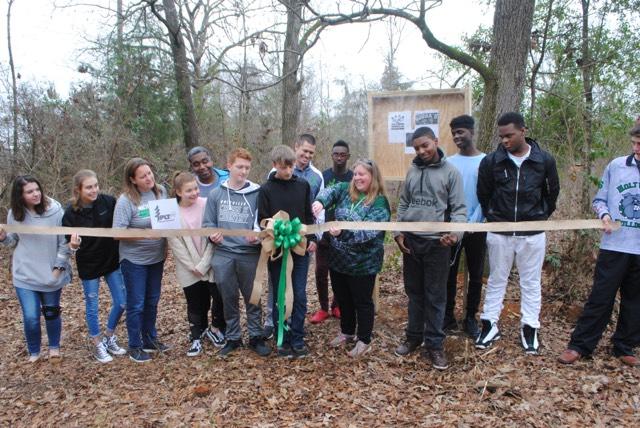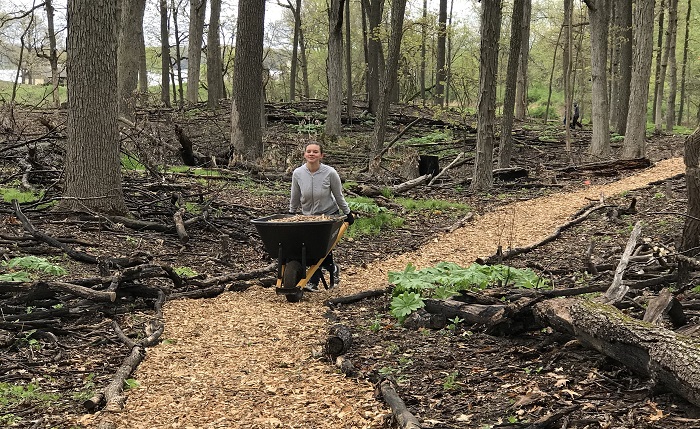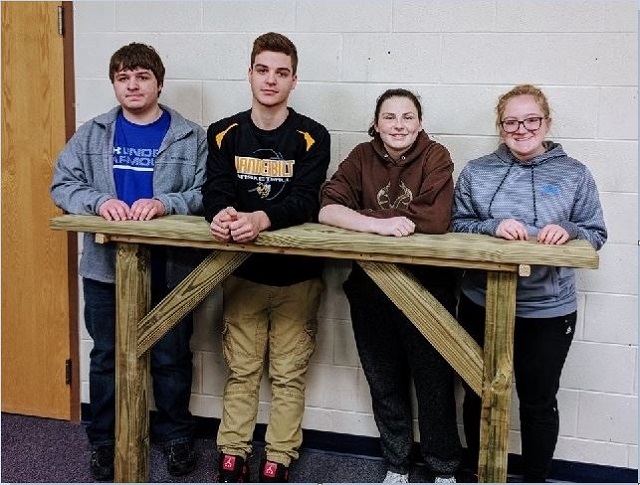National Trails Day is June 5, 2021. The American Hiking Society’s annual event is a timely reminder (and depending on where you live) might be a perfect day to reconnect with nature.
But not all trails are found exclusively on public lands; thanks to grants from PLT’s GreenWorks! service learning program, three schools went a step further—pardon the pun—by involving students not only in walking on trails, but also in designing and building them on school grounds.
High school students in Alabama designed a nature trail with informational signage and seating; middle school students in Indiana removed invasive species and installed part of a hiking trail; and industrial arts students in Michigan built an outdoor classroom alongside a trail in their 110-acre school forest. Two of the schools, Holtville High in Alabama and Vanderbilt Area School in Michigan, have land near their school where trails were built. Fremont Middle School in Indiana worked on a trail at a community nature preserve.
Below, read about these projects and tips from the educators to make them successful.
Building from the Ground Up

At Holtville High School in Deatsville, AL, science teacher Liz Johnson coordinated a project that fulfilled a long-held dream by teachers and students: a nature trail with informational signage and seating. “Students in science and agriculture classes designed it, learning planning and problem-solving while also learning about forest succession and other environmental topics.
The school district owned the land but had leased it for grazing. Allowing the farmer the required time to move his cattle, coupled with syncing schedules with community partners, caused the project to start a semester later than expected—the first lesson the students got in flexibility.
“Our students stepped up and took full control,” Johnson said. “The trail project allowed students real-time, hands-on experiences with working with tools, managing a budget, conversing with successful community businessmen, and building relationships between students and adults within and outside our school.”
In connecting her curriculum with the trail project, Johnson used two PLT activities from the Biodiversity supplement: Global Invaders and Protected Areas. Johnson found an adaptation of the PreK-8 activity Nothing Succeeds Like Succession to work well.
Johnson’s Tips for the Trail
- Touch base with community partners frequently and share how much you appreciate them and their services.
- Let students take leadership roles. Working with teenagers has its challenges, and it may take students a while to realize too many leaders can be detrimental to a project, but if students step up and take the lead, try new things, and get out of their comfort zones, there can be no such thing as failure, only learning opportunities. There were many times my students wanted to do things differently than I wanted to, but I let them lead this project and do things their way (within reason).
- Try to stay in line with your timeline. While the unexpected is expected, planning is key for a project of this magnitude. Holding to your timeline will eliminate unnecessary stress.
- Consult with a local nature center in planning the materials to use. We did not consider options for the substrate for the trail (mulch, sand/clay mix, etc.) until after our proposal was accepted. At that time, it was too late to edit the budget. In the future, we would like to mulch our trail and “dress it up” a little bit.
Partnering for a Trail

The Clear Lake Nature Preserve and Brennan Woods, operated by the Clear Lake Township Land Conservancy, Inc., in Fremont, IN, encompasses 45 acres to connect with nature and learn about threatened ecosystems. The Conservancy decided to involve students to strengthen the connection. Eighth graders at Fremont Middle School identified and removed invasive species and installed part of a hiking trail.
“The outcome was the trails they built and the ownership they can now take in the land that makes up their community,” said Bridget Harrison, a conservancy staff member. In fact, they accomplished so much that the supplies of wood chips and wheelbarrows were exhausted.
Even the less fun parts of the project—removing bags full of litter—had a teachable moment. “We know how frustrating it was for them to remove garbage bags full of litter,” Harrison conceded. “We think that effort will play a lasting role the next time they are tempted to toss their garbage onto the ground.” After the clean-up and at the students’ suggestion, “No Dumping” signs were installed at key spots along the trail.
Harrison used the PLT PreK-8 activities Invasive Species and I’d Like to Visit a Place Where…. during two classroom visits before the students came to the Conservancy. The first activity “helped students learn what invasive species are; we took that knowledge and applied it right in the field,” Harrison said. The latter activity about favorite recreational spaces engaged the students’ creativity.
Harrison’s Tips for the Trail
- If you’re working with a large group, split them into smaller teams with group leaders.
- Prepare for bad weather. The outdoor project began with a downpour. Decks of cards and games, not to mention a back-up place out of the elements, kept order.
- Build on lessons learned. As noted above, the students were so enthusiastic that they could have used more wheelbarrows and ran out of wood chips. “Good lessons for us to consider for future trail-building workdays,” Harrison said.
Adding on to a Trail

The Vanderbilt Area School in Gaylord, MI, had installed a trail in 2017 in its 110-acre school forest. With a 2018 GreenWorks! grant, industrial arts students took the lead in planning and building an outdoor classroom alongside the trail. Emily Vogelgesang, the environmental education coordinator at the nonprofit Huron Pines, worked with the school to provide support through natural resource and educational connection guidance.
“The most successful element of the project has been the student leadership,” said Vogelgesang. “Students took on a role in their school they normally wouldn’t have and were proud of that.” A highlight was when they brought a group of about 20 community leaders and natural resource partners out on the trail to explain their plans.
A late spring snow storm and a rainy autumn caused a delay, with some of the students involved in the planning not able to see it through to completion. Despite this setback, they recognized their role in creating a usable space for the entire student body.
The school has both elementary and secondary levels, and PLT is used in many grades. The 1st grade/2nd grade teacher used Adopt a Tree to help monitor forest health on a select group of trees. High school students worked through a modified version of I’d Like to Visit a Place Where as part of the planning for the outdoor classroom. “The activity was particularly helpful for them to make connections to the larger why of the project and understand that their work is part of something bigger,” Vogelgesang said. All students participated in elements of Reduce, Reuse, Recycle activity through the Earth Day Bag Project.
Vogelgesang’s Tips for the Trail
- Help students understand the needs of the people who will use the space. Students’ initial thoughts and designs were great but once they went through the interview process with teachers, they realized the first drafts were not going to be what teachers would utilize consistently. Being able to have input from several points of view is very important for this type of space to be successful.
- Ensure school or community support for the necessary tools and resources. Without a community member who helped teach the students how to use the tools, the outdoor classroom elements would not have come together.
- Enlist adult volunteers when necessary. There was a large amount the students handled fine with just teacher guidance but having extra hands at certain points made the project easier.
- Have a flexible timeline. Weather conditions and school schedules may mean the project takes longer to complete. However, the longer timeline can increase student ownership and pride.


